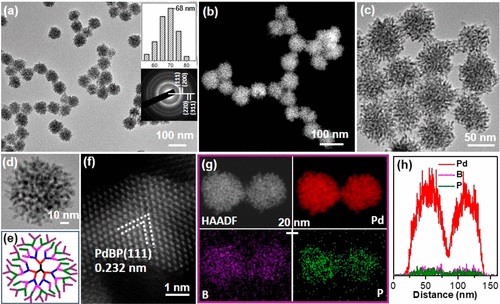刘犇教授课题组在ACS NANO发表研究论文
Ternary Palladium-Boron-Phosphorus Alloy Mesoporous Nanospheres for Highly Efficient Electrocatalysis
Lv, H (Lv, Hao)[ 1 ] ; Xu, DD (Xu, Dongdong)[ 1 ] ; Sun, LZ (Sun, Lizhi)[ 1 ] ; Henzie, J (Henzie, Joel)[ 2,3 ] ; Suib, SL (Suib, Steven L.)[ 4,5 ] ; Yamauchi, Y (Yamauchi, Yusuke)[ 2,6,7,8 ] ; Liu, B (Liu, Ben)[ 1 ]*(刘犇)
[ 1 ] Nanjing Normal Univ, Sch Chem & Mat Sci, Jiangsu Collaborat Innovat Ctr Biomed Funct Mat, Jiangsu Key Lab New Power Batteries, Nanjing 210023, Jiangsu, Peoples R China
[ 2 ] Qingdao Univ Sci & Technol, Coll Chem & Mol Engn, Key Lab Ecochem Engn, Qingdao 266042, Shandong, Peoples R China
[ 3 ] NIMS, Int Ctr Mat Nanoarchitecton, WPI MANA, 1-1 Namiki, Tsukuba, Ibaraki 3050044, Japan
[ 4 ] Univ Connecticut, Dept Chem, Storrs, CT 06269 USA
[ 5 ] Univ Connecticut, Inst Mat Sci, Storrs, CT 06269 USA
[ 6 ] Univ Queensland, Sch Chem Engn, Brisbane, Qld 4072, Australia
[ 7 ] Univ Queensland, AIBN, Brisbane, Qld 4072, Australia
[ 8 ] Kyung Hee Univ, Dept Plant & Environm New Resources, 1732 Deogyeong Daero, Yongin 446701, Gyeonggi Do, South Korea
ACS NANO,201910,13(10),12052-12061
Alloying palladium (Pd) catalysts with various metalloid and nonmetal elements can improve their catalytic performance in different chemical reactions. However, current nanosynthesis methods can only generate Pd alloys containing one metalloid or nonmetal, which limits the types of element combinations that may be used to improve Pd-based nanocatalysts. Herein, we report a simple soft-templating synthetic strategy to co-alloy Pd with the metalloid boron (B) and the nonmetal phosphorus (P) to generate ternary PdBP mesoporous nanospheres (MSs) with three-dimensional dendritic frameworks. We use a one-step aqueous synthesis method where dimethylamine borane and sodium hypophosphite serve as the B and P sources, respectively, as well as the co-reducing agents to drive the nucleation and growth of ternary PdBP alloy on a sacrificial dioctadecyldimethylammonium chloride template. The concentration of metalloid to nonmetal and the diameters of dendritic MSs can be tailored. The synthetic protocol is also extended to other multicomponent PdMBP alloy MSs to generate different types of dendritic mesoporous frameworks. Boron and phosphorus are known to accelerate the kinetics of the electrochemical oxygen reduction reaction (ORR) and alcohol oxidation reactions (AORs), because their alloys promote the decomposition of oxygen-containing intermediates on Pd surfaces. The dendritic mesoporous morphology of the ternary PdBP MSs also accelerates electron/mass transfer and exposes numerous active sites, enabling better performance in the ORR and AORs. Extending the surfactant-templating synthetic route to multiple types of elements will enable the generation of libraries of multicomponent metal-metalloid-nonmetal alloy nanostructures with functions that are suitable for various targeted applications.

文章链接:
https://pubs.acs.org/doi/10.1021/acsnano.9b06339
版权与免责声明:本网页的内容由收集互联网上公开发布的信息整理获得。目的在于传递信息及分享,并不意味着赞同其观点或证实其真实性,也不构成其他建议。仅提供交流平台,不为其版权负责。如涉及侵权,请联系我们及时修改或删除。邮箱:sales@allpeptide.com